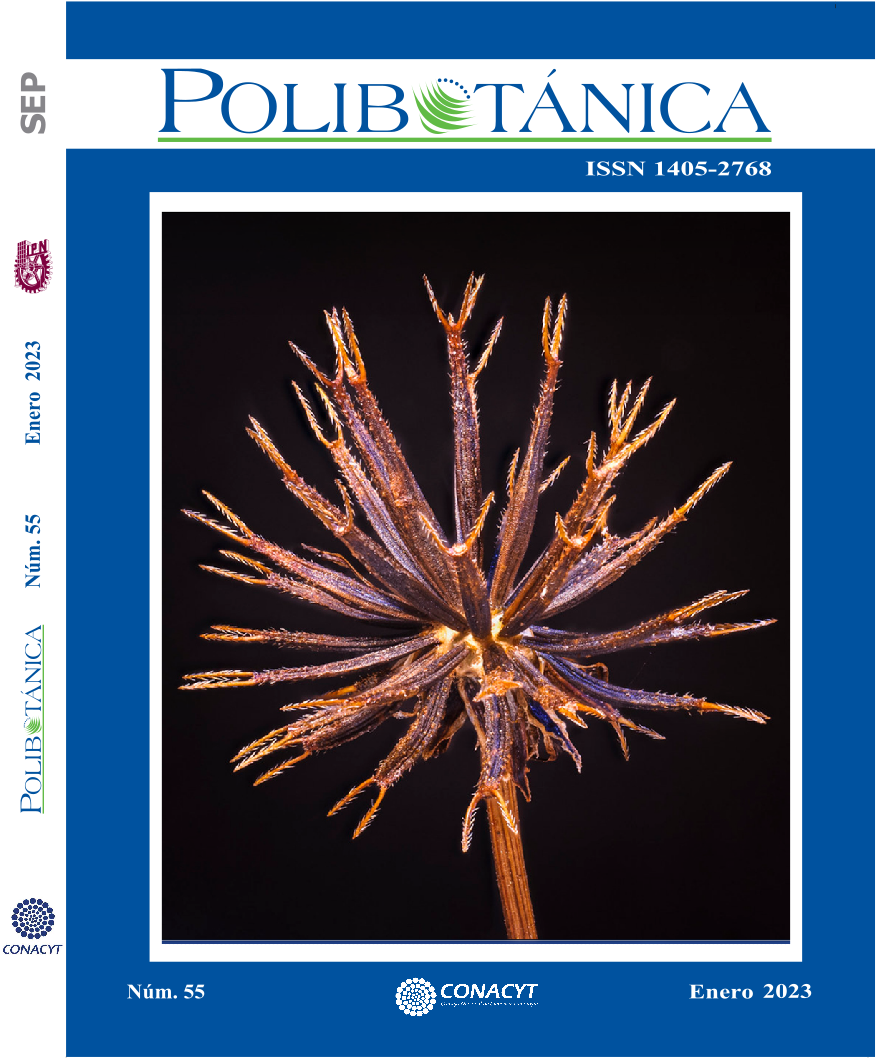Response in the antioxidant defense system of Leersia hexandra Sw. to the exposure of petroleum hydrocarbons
DOI:
https://doi.org/10.18387/polibotanica.55.16Keywords:
petroleum, grass, reactive oxygen species, growth, photo-synthetic pigments.Abstract
This study was conducted to assess the impact of petroleum hydrocarbon toxicity on growth, fresh biomass production, photosynthetic pigments and antioxidant response in Leersia hexandra after 180 days. A completely randomized experimental design was performed under semi-controlled conditions in a micro-tunnel, with four treatments and four replicates per treatment. The concentrations were: 0 (control), 30, 60 and 90 g kg-1 of total petroleum hydrocarbons (TPH). The results showed that TPH concentrations in the soil affected growth by reducing height (r= -0.940**), primary root length (r= -0.961**) and aerial fresh matter production (r= - 0.901**), however, they induced an increase in the number of shoots in the tiller (r= 0.970**), number of primary roots (r= 0.995**), production of fresh root matter (r= 0.882**), content of photosynthetic pigments and total proteins (TPr) (r= 0.716**). In addition, high doses of TPH have led to the generation of reactive oxygen species (ROS), such as hydrogen peroxide (H2O2), which has increased at doses of 60 and 90 g kg-1 TPH. Increasing activities of β-carotene, Vitamin C (VC), total phenols (TP), flavonoids (FV) in L. hexandra leaves are involved in the removal of ROS.
References
Adams, R.H.; F.J. Guzmán-Osorio, y J. Zavala-Cruz, 2008b. “Water repellency in oil contaminated sandy and clayey soils”. Int. J. Environ. Sci. Technol, 5: 445-454. https://doi.org/10.1007/BF03326040
Adams, R.H.; J. Zavala-Cruz, y F. Morales-García, 2008a. “Concentración residual de hidrocarburos en suelo del trópico. II. Afectación a la fertilidad y su recuperación”. Interciencia, 33: 483-489.
Agati, G.; E. Azzarello, S. Pollastri, S, y M. Tattini, 2012. “Flavonoids as antioxidants in plants: Location and functional significance”. Plant. Sci, 196: 67-76. https://doi.org/10.1016/j.plantsci.2012.07.014
Aislabie, J.; D. Saul, y J. Foght, 2006. “Bioremediation of hydrocarbon-contaminated polar soils”. Extremophiles, 10: 171-179. https://doi.org/10.1007/s00792-005-0498-4
Arellano, P.; K. Tansey, H. Balzter, y D.S. Boyd, 2015. “Detecting the effects of hydrocarbon pollution in the Amazon forest using hyperspectral satellite images”. Environ. Pollut, 205: 225-239. https://doi.org/10.1016/j.envpol.2015.05.041
Arias-Trinidad, A.; M.C. Rivera-Cruz, A. Roldán-Garrigós, A. Aceves-Navarro, R. Quintero-Lizaola, y J. Hernández-Guzmán, 2017. “Uso de Leersia hexandra (Poaceae) en la fitorremediación de suelos contaminados con petróleo fresco e intemperizado”. Rev. Biol. Trop, 65: 21-30. https://doi.org/10.15517/RBT.V65I1.22967
Arvouet-Grand, A.; B. Vennat, A. Pourrat, y P. Legret, 1994. “Standardization of propolis extract and identification of principal constituents”. J. Pharm. Belg, 49: 462–468.
Bienert, G.P.; A.L.B. Møller, y K.A. Kristiansen, 2007. “Specific aquaporins facilitate the diffusion of hydrogen peroxide across membranes”. J. Biol. Chem, 282: 1183-1192. https://doi.org/10.1074/jbc.M603761200
Bradford, M.M., 1976. “A Rapid and sensitive method for the quantification of microgram quantities of protein utilizing the principle of protein-dye binding”. Anal. Biochem, 72: 248-254. https://doi.org/10.1016/0003-2697(76)90527-3
CABI, 2019. “Centre for Agricultural Bioscience International”. Invasive Species Compendium. Wallingford, Reino Unido: CAB International. https://www.cabi.org/isc/datasheet/30391. Fecha de consulta 20 de junio del 2022.
Cai, Z.; Q. Zhou, S. Peng, y K. Li, 2010. “Promoted biodegradation and microbiological effects of petroleum hydrocarbons by Impatiens balsamina L. with strong endurance”. J. Hazard Mater, 183: 731-737. https://doi.org/10.1016/j.jhazmat.2010.07.087
Cartmill, A.D.; D.L. Cartmill, y A. Alarcón, 2014. “Controlled release fertilizer increased phytoremediation of petroleum-contaminated sandy soil”. Int. J. Phytoremediat, 16: 285-301. https://doi.org/10.1080/15226514.2013.773280
Chandra, S.; R. Sharma, K. Singh, y A. Sharma, 2013. “Application of bioremediation technology in the environment contaminated with petroleum hydrocarbon”. Ann. Microbiol, 63:417-431. https://doi.org/10.1007/s13213-012-0543-3
Cochrane, F.C.; L.B. Davin, y N.G. Lewis, 2004. “The Arabidopsis phenylalanine ammonia lyase gene family: kinetic characterization of the four PAL isoforms”. Phytochemistry, 65: 1557-1564. https://doi.org/10.1016/j.phytochem.2004.05.006
Corpas, F.J.; L.A. del Río, y J.M. Palma, 2019. “Plant peroxisomes at the crossroad of NO and H2O2 metabolism”. J. Integ. Plant Biol, 61: 803-816. https://doi.org/10.1111/jipb.12772
Cumplido-Nájera, C.F.; S. González-Morales, H. Ortega-Ortíz, G. Cadenas-Pliego, A. Benavides-Mendoza, y A. Juárez-Maldonado, 2019. “The application of copper nanoparticles and potassium silicate stimulate the tolerance to Clavibacter michiganensis in tomato plants”. Sci. Hortic, 245: 82–89. https://doi.org/10.1016/j.scienta.2018.10.007
Dangles, O., 2012. “Antioxidant Activity of Plant Phenols: Chemical Mechanisms and Biological Significance”. Curr. Org. Chem, 16: 692-714. https://doi.org/10.2174/138527212799957995
Da Silva, C.H., y M.L. Teresinha, 2021. “The potential association of Echinochloa polystachya (Kunth) Hitchc. with bacterial consortium for petroleum degradation in contaminated soil”. Appl. Sci, 3: 80. https://doi.org/10.1007/s42452-020-04070-6
Del Río, L.A., 2015. “ROS and RNS in plant physiology: an overview”. J. Exp. Bot, 66: 2827-2837. https://doi.org/10.1093/jxb/erv099
Dhindsa, R.S.; P. Plumb-Dhindsa, y T.A. Thorpe, 1981. “Leaf senescence: correlated with increased levels of membrane permeability and lipid peroxidation, and decrease levels of superoxide dismutase and catalase”. J. Exp. Bot, 32: 93-101. https://doi.org/10.1093/jxb/32.1.93
Díaz-Martínez, M.E.; A. Alarcón, R. Ferrera-Cerrato, J.J. Almaraz-Suarez, y O. García-Barradas, 2013. “Crecimiento de Casuarina equisetifolia (Casuarinaceae) en suelo con diésel, y aplicación de bioestimulación y bioaumentación”. Rev. Biol. Trop, 61: 1039-1052. https://doi.org/10.15517/rbt.v61i3.11779
Escaso, S.F.; G.J.L. Martínez, y C.M.R. Planelló, 2010. “Fundamentos Básicos de Fisiología Vegetal y Animal”. Pearson Educación, SA, Madrid, España. 251 pp.
Eze, M. O.; G.C. Hose, y S.C. George, 2020. “Assessing the Effect of Diesel Fuel on the Seed Viability and Germination of Medicago sativa Using the Event-Time Model”. Plants, 9: 1062. https://doi.org/10.3390/plants9091062
González-Moscoso, M.; M.C. Rivera-Cruz, J. Delgadillo-Martínez, y L.C. Lagunes-Espinoza, 2017. “Growth analysis and plant production of Leersia hexandra Swartz in tropic wet mexican in fuction on petroleum and surfactant”. Polibotánica, 43: 177-196. https://doi.org/10.18387/polibotanica.43.8
Hasanuzzaman, M.; M.H.M.B. Bhuyan, F. Zulfiqar, A. Raza, S.M. Mohsin, J.A. Mahmud, M. Fujita, y V. Fotopoulos, 2020. “Reactive Oxygen Species and Antioxidant Defense in Plants under Abiotic Stress: Revisiting the Crucial Role of a Universal Defense Regulator”. Antioxidants, 9: 681. https://doi.org/10.3390/antiox9080681
Heldt H.W., y B. Piechulla, 2011. “Phenylpropanoids comprise a multitude of plant secondary metabolites and cell wall components”. In H. Hans-Walter, y B. Piechulla (Eds.), Plant Biochemistry (4th ed., pp. 431-449). Academic Press. https://doi.org/10.1016/B978-0-12-384986-1.00018-1
Hernández, I.; L. Alegre, F. Van Breusegem, y S. Munné-Bosch, 2009. “How relevant are flavonoids as antioxidants in plants?”. Trends. Plant. Sci, 14: 125-132. https://doi.org/10.1016/j.tplants.2008.12.003
Hernández-Valencia, I.; L.M. Lárez, y J.V. García, 2017. “Evaluación de la toxicidad de un suelo contaminado con diferentes tipos de crudos sobre la germinación de dos pastos tropicales”. Bioagro, 29: 73-82.
Hou, F. S.; M.W. Milke, D.W. Leung, y D.J. MacPherson, 2001. “Variations in phytoremediation performance with diesel-contaminated soil”. Environ. Technol, 22: 215-222. https://dx.doi.org/10.1080/09593332208618301
Huang, H.; F. Ullah, D.X. Zhou, M. Yi, y Y. Zhao, 2019. “Mechanisms of ROS Regulation of Plant Development and Stress Responses”. Front. Plant. Sci, 10: 1-10. https://doi.org/10.3389/fpls.2019.00800
Hung, C.Y., y G.C. Yen, 2002. “Antioxidant activity of phenolic compounds isolated from Mesona procumbens Hemsl”. J. Agr. Food Chem., 50: 2993-2997. https://doi.org/10.1021/jf011454y
Hussain, F.; F. Hadi, y Q. Rongliang, 2021. “Effects of zinc oxide nanoparticles on antioxidants, chlorophyll contents, and proline in Persicaria hydropiper L. and its potential for Pb phytoremediation”. Environ. Sci. Pollut. Res, 28: 34697-34713 https://doi.org/10.1007/s11356-021-13132-0
Hussain, I.; M. Puschenreiter, S. Gerhard, P. Schöftner, S. Yousaf, A. Wang, S.J. Hussain, y T.G. Reichenauer, 2018. “Rhizoremediation of petroleum hydrocarbon-contaminated soils: Improvement opportunities and field applications”. Environ. Exp. Bot, 147: 202-219. https://doi.org/10.1016/j.envexpbot.2017.12.016
Janzen, S.J., y T.L. Teresinha, 2018. “Rhizospheric microorganisms as a solution for the recovery of soils contaminated by petroleum: A review”. J. Environ. Manage, 210: 104-113. https://doi.org/10.1016/j.jenvman.2018.01.015
Kapoor, D.; S. Singh, V. Kumar, R. Romero, R. Prasad, y J. Singh, 2019. “Antioxidant enzymes regulation in plants in reference to reactive oxygen species (ROS) and reactive nitrogen species (RNS)”. Plant Gene, 19: 100182. https://doi.org/10.1016/j.plgene.2019.100182
Kaur, R., y H. Nayyar, 2014. “Ascorbic Acid: A Potent Defender Against Environmental Stresses”. In P. Ahmad (Ed.), Oxidative Damage to Plants: Antioxidant Networks and Signaling (pp. 235-287). Cambridge, MA, USA: Elsevier. https://doi.org/10.1016/B978-0-12-799963-0.00008-3
Kosyk, O.I.; M.I. Khomenko, L.M. Batsmanova, y T.N. Yu, 2017. “Phenylalanine ammonia-lyase activity and anthocyanin content in different varieties of lettuce under the cadmium influence”. Biochem. J, 89: 85-91. doi: https://doi.org/10.15407/ubj89.02.085
Li, H.; H. Luo, D. Li, T. Hu, y J. Fu, 2012. “Antioxidant Enzyme Activity and Gene Expression in Response to Lead Stress in Perennial Ryegrass”. J. Am. Soc. Hortic. Sci, 137: 80-85. https://doi.org/10.21273/JASHS.137.2.80
Madigan, M.T.; J.M. Martinko, K.S. Bender, D.H. Buckley, y D.A. Stahl, 2015. “Brock. Biología de los Microorganismos”. 14a. edición. Pearson Educación, S.A. Madrid, España.1099 pp.
Mena, E.; J. Villaseñor, M.A. Rodrigo, y P. Cañizares, 2016. “Electrokinetic remediation of soil polluted with insoluble organics using biological permeable reactive barriers: Effect of periodic polarity reversal and voltage gradient”. Chem. Eng. J, 299: 30-36. https://doi.org/10.1016/j.cej.2016.04.049
Merkl, N.; R. Schultze-Kraft, y C. Infante, 2005. “Assessment of tropical grasses and legumes for phytoremediation of petroleum-contaminated soils”. Water Air Soil Poll, 165: 195-209. https://doi.org/10.1007/s11270-005-4979-y
Mhamdi, A., y F. van Breusegem, 2018. “Reactive oxygen species in plant development”. Development, 145: 15. https://doi.org/10.1242/dev.164376
Mhamdi, A.; G. Noctor, y A. Baker, 2012. “Plant catalases: Peroxisomal redox guardians”. Arch. Biochem. Biophys, 525: 181-194. https://doi.org/10.1016/j.abb.2012.04.015
Mirzahosseini, Z.; L. Shabani, M.R. Sabzalian, y M. Sharifi-Tehrani, 2014. “Neotyphodium endophytes may increase tolerance to Ni in tall fescue”. Eur. J. Soil Biol, 63: 33-40. https://doi.org/10.1016/j.ejsobi.2014.05.004
Mittler, R., 2017. “ROS Are Good”. Trends Plant Sci, 22: 11-9. https://doi.org/10.1016/j.tplants.2016.08.002
Nagata, M., y I. Yamashita, 1992. “Simple method for simultaneous determination of chlorophyll and carotenoids in tomato fruit”. Nippon Shokuhin Kogyo Gakkaishi, 39: 925–928. https://doi.org/10.3136/nskkk1962.39.925
Nardeli, S.M.; C.F. Saad, P.B. Rossetto, V.S. Caetano, M. Ribeiro-Alves, J.E.S. Paes, R. Danielowski, L.C. Maia, A.C. Oliveira, R.S. Peixoto, F. Reinert, y M. Alves-Ferreira, 2016. “Transcriptional responses of Arabidopsis thaliana to oil contamination”. Environ. Exp. Bot, 127: 63-72. https://doi.org/10.1016/j.envexpbot.2016.03.007
Noomen, M. F.; A.K. Skidmore, F.D. van der Meer, y H.H.T. Prins, 2006. “Continuum removed band depth analysis for detecting the effects of natural gas, methane and ethane on maize reflectance”. Remote Sens. Environ, 105: 262-270. https://doi.org/10.1016/j.rse.2006.07.009
Noomen, M.F., y A.K. Skidmore, 2009. “The effects of high soil CO2 concentrations on leaf reflectance of maize plants”. Int. J. Remote Sens, 30: 481-497. https://doi.org/10.1080/01431160802339431
Orocio-Carrillo, J.A.; M.C. Rivera-Cruz, E.M. Aranda-Ibañez, A. Trujillo-Narcía, G. Hernández-Galvez, y M.R. Mendoza-López, 2019. “Hormesis under oil-induced stress in Leersia hexandra Sw. used as phytoremediator in clay soils of the Mexican humid tropic”. Ecotoxicology, 28: 1063-1074. https://doi.org/10.1007/s10646-019-02106-1
Ortiz-Espín, A.; A. Sánchez-Guerrero, F. Sevilla, y A. Jiménez, 2017. “The Role of Ascorbate in Plant Growth and Development”. In M. A. Hossain, S. Munné-Bosch, D. J. Burritt, P. Diaz-Vivancos, M. Fujita, y A. Lorence, A (Eds.), Ascorbic Acid in Plant Growth, Development and Stress Tolerance (pp. 25-45). Cham, Switzerland: Springer International. https://doi.org/10.1007/978-3-319-74057-7_2
Palma, J. M.; R.M. Mateos, J. López-Jaramillo, M. Rodríguez-Ruiz, S. González-Gordo, A.M. Lechuga-Sancho, y F.J Corpas, 2020. “Plant catalases as NO and H2S targets”. Redox Biol, 34: 101525. https://doi.org/10.1016/j.redox.2020.101525
Petenello, M.C., y S.R. Feldman, 2012. “Evaluación de la tolerancia a suelos contaminados con aceite diésel en especies vegetales con potencial biorremediador”. Acta Biol. Colomb, 17: 589-598.
Pezeshki, S.R.; M.W. Hester, Q. Lin, y J.A. Nyman, 2000. “The effects of oil spill and clean-up on dominant US Gulf coast marsh macrophytes: a review”. Environ. Pollut, 108: 129-139. https://doi.org/10.1016/S0269-7491(99)00244-4
Pollastri, S., y M. Tattini, 2011. “Flavonols: old compounds for old roles”. Ann. Bot, 108: 1225-1233. https://doi.org/10.1093/aob/mcr234
PROFEPA, 2018. “Procuraduría Federal de Protección al Ambiente”. https://www.gob.mx/profepa/prensa/atiende-profepa-emergencias-ambientales-y-restauracion-de-sitios-contaminados-hasta-su-total-remediacion. Fecha de consulta 21 de febrero del 2022.
Qin, G.; Q. Wang, J. Liu, B. Li, y S. Tian, 2009. “Proteomic analysis of changes in mitochondrial protein expression during fruit senescence”. Proteomics, 9: 4241-4253. https://doi.org/10.3390/molecules25040873
Rasheed, F.; J. Markgren, M. Hedenqvist. y E. Johansson, 2020. “Modeling to Understand Plant Protein Structure-Function Relationships-Implications for Seed Storage Proteins”. Molecules, 25: 873. https://doi.org/10.3390/molecules25040873
Rivera-Cruz, M.C., 2011. “Flora y microflora rizosférica del pantano: indicadoras de perturbación causada por petróleo e inundación”. Agroregión, 5: 12-15.
Rivera-Cruz, M.C., y A. Trujillo-Narcía, 2004. “Estudio de toxicidad vegetal en suelos con petróleos nuevo e intemperizado”. Interciencia, 29: 369-376.
Rivera-Cruz, M.C.; A. Trujillo-Narcía, E.A. Trujillo-Rivera, A. Arias-Trinidad, y M.R. Mendoza- López, 2016. “Natural attenuation of weathered oil using aquatic plants in a farm in southeast Mexico”. Int. J. Phytoremediat, 18: 877-884. https://doi.org/10.1080/15226514.2016.1156632
Rodríguez-Rodríguez, N.; M.C. Rivera-Cruz, A. Trujillo-Narcía, J. Almaráz-Suárez, y S. Salgado-García, 2016. “Spatial Distribution of Oil and Biostimulation Through the Rhizosphere of Leersia hexandra in Degraded Soil”. Water Air Soil Pollut, 227: 319. https://doi.org/319. 10.1007/s11270-016-3030-9
Rusin, M.; J. Gospodarek, G. Barczyk, y A. Nadgórska-Socha, 2018. “Antioxidant responses of Triticum aestivum plants to petroleum-derived substances”. Ecotoxicology, 27: 1353-1367. https://doi.org/10.1007/s10646-018-1988-3
Sangabriel, W.; R. Ferrera-Cerrato, D. Trejo-Aguilar, M.R. Mendoza-López, J.S. Cruz-Sánchez, C. López-Ortiz, J. Delgadillo-Martínez, y A. Alarcón, 2006. “Tolerancia y capacidad de fitorremediación de combustóleo en el suelo por seis especies vegetales”. Rev. Int. Contam. Ambie, 22: 63-73.
Sangeetha J., y D. Thangadurai, 2014. “Effect of biologically treated petroleum sludge on seed germination and seedling growth of Vigna unguiculata (L.) Walp. (Fabaceae)”. Braz. Arch. Biol. Techn, 57: 427-433. https://doi.org/10.1590/S1516-89132014005000011
SAS (Statiscal Analysis Systems), 2005. “User´s Guide”, Versión 9.1.3. SAS Institute, Inc. Cary, NC., 664 pp.
Sharma, P.; J.A. Bhushan, D.R. Shanker, y M. Pessarakli, 2012. “Reactive Oxygen Species, Oxidative Damage, and Antioxidative Defense Mechanism in Plants under Stressful Conditions”. J. Bot, 2012, 1-26. https://doi.org/10.1155/2012/217037
Singh, G. S., y N. Tuteja, 2010. “Reactive oxygen species and antioxidant machinery in abiotic stress tolerance in crop plants”. Plant Physiol. Bioch, 48: 909-930. https://doi.org/10.1016/j.plaphy.2010.08.016
Skrypnik, L.; P. Maslennikov, A. Novikova, y M. Kozhikin, 2021. “Effect of Crude Oil on Growth, Oxidative Stress and Response of Antioxidative System of Two Rye (Secale cereale L.) Varieties”. Plants, 10: 157. https://doi.org/10.3390/plants10010157
Sykłowska-Baranek, K.; M. Grech-Baran, M.R. Naliwajski, y A. Pietrosiuk, 2015. “Paclitaxel production and PAL activity in hairy root cultures of Taxus x media var. Hicksii carrying a taxadiene synthase transgene elicited with nitric oxide and methyl jasmonate”. Acta Physiol. Plant, 37: 218. https://doi.org/10.1007/s11738-015-1949-x
Tabassum, S.; N. Shahid, J. Wang, M. Shafid, M. Mumtaz, y M. Arslan, 2016. “The Oxidative Stress Response of Mirabilis jalapa to Exhausted Engine Oil (EEO) during Phytoremediation”. Pol. J. Environ. Stud, 25: 2581-2587. https://doi.org/10.15244/pjoes/61960
Tadeo, F.R., y A. Gómez-Cadenas, 2008. “Fisiología de las plantas y el estrés”. In J. Azcón-Bieto, y M. Talón (Eds.), Fundamentos de fisiología vegetal (2da ed., pp. 557-594). Madrid, España: McGraw-Hill Interamericana.
Trujillo-Narcía, A.; M.C. Rivera-Cruz, L.C. Lagunes-Espinoza, D.J. Palma-López, S. Soto-Sánchez, y G. Ramírez-Valverde, 2012. “Efecto de la restauración de un fluvisol contaminado con petróleo crudo”. Rev. Int. Contam. Ambie, 28: 361-374.
Varjani, S.J., 2017. “Microbial degradation of petroleum hydrocarbons”. Bioresource Technol, 223: 277-286. https://doi.org/10.1016/j.biortech.2016.10.037
Vegetti, A.C., 2002. “Caracterización de los sistemas de ramificación en especies de Oryzeae (Poaceae)”. Candollea, 57: 251-260.
Velikova, V.; I. Yordanov, y A. Edreva, 2000. “Oxidative stress and some antioxidant systems in acid rain-treated bean plants: Protective role of exogenous polyamines”. Plant Sci, 151: 59-66. https://doi.org/10.1016/S0168-9452(99)00197-1
Walkley, A., y I.A. Black, 1934. “An Examination of the Degtjareff Method for Determining Soil Organic Matter, and a Proposed Modification of the Chromic Acid Titration Method”. Soil Sci, 37: 29-38. https://doi.org/10.1097/00010694-193401000-00003
Wang, L.; Z. Liu, H. Jiang, y X. Mao, 2021. “Biotechnology advances in β-carotene production by microorganisms”. Trends Food Sci. Tech, 111: 322-332. https://doi.org/10.1016/j.tifs.2021.02.077
Weihong, X.U.; L.I. Wenyi, H.E. Jianping, B. Singh, y X. Zhiting, 2009. “Effects of insoluble Zn, Cd, and EDTA on the growth, activities of antioxidant enzymes and uptake of Zn and Cd in Vetiveria zizanioides”. J. Environ. Sci, 21: 186–192. https://doi.org/10.1016/S1001-0742(08)62249-4
Xie, X.; Z. He, N. Chen, Z. Tang, Q. Wang, y Y. Cai, 2019. “The Roles of Environmental Factors in Regulation of Oxidative Stress in Plant”. BioMed Res. Int, 2019: 1-11. https://doi.org/10.1155/2019/9732325
Zainab, Q.; T.C. Muhammad, D. Xiongming, H. Lori, y T. Muhammad, 2021. “Review of oxidative stress and antioxidative defense mechanisms in Gossypium hirsutum L. in response to extreme abiotic conditions”. J. Cotton Res, 4: 1-9. https://doi.org/10.1186/s42397-021-00086-4
Zamora, A.; J. Ramos, y M. Arias, 2012. “Efectos de la contaminación por hidrocarburos sobre algunas propiedades químicas y microbiológicas de un suelo de sabana”. Bioagro, 24: 5-12.
Zhang, X., y C.J. Liu, 2015. “Multifaceted Regulations of Gateway Enzyme Phenylalanine Ammonia-Lyase in the Biosynthesis of Phenylpropanoids”. Mol. Plant, 8: 17-27. https://doi.org/10.1016/j.molp.2014.11.001
Downloads
Published
Issue
Section
License

Polibotánica by Departamento de Botánica de la Escuela Nacional de Ciencias Biológicas del Instituto Politécnico Nacional se distribuye bajo una Licencia Creative Commons Atribución-NoComercial-CompartirIgual 4.0 Internacional.




















